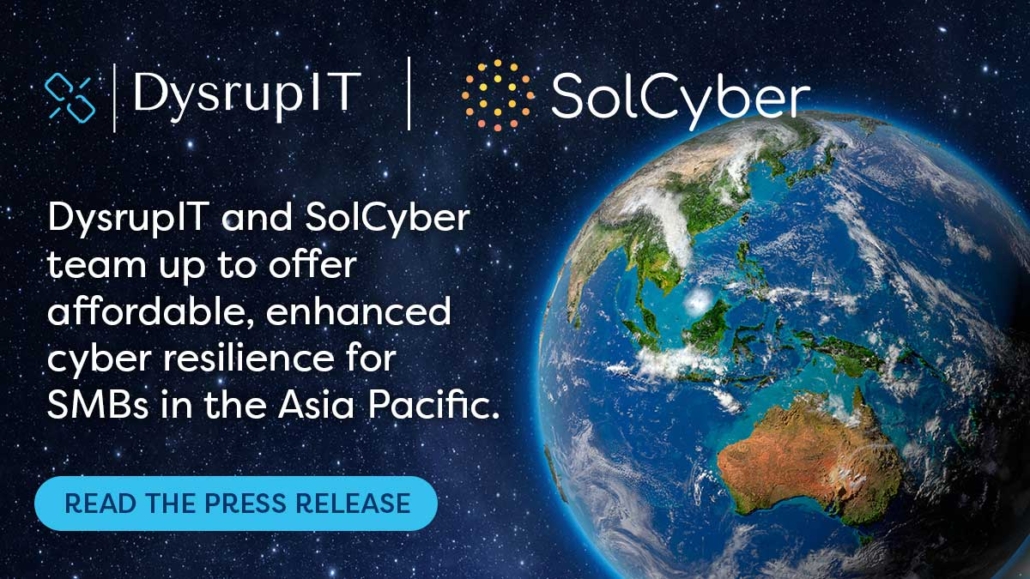DysrupIT™ and SolCyber Partner to Offer 24/7 Managed Security Service for Small and Medium Businesses
Providing round-the-clock protection to keep businesses secure.
SYDNEY, AUSTRALIA – Cloud and as-a-Service advocate, DysrupIT™ has announced a strategic alliance with managed security services provider, SolCyber. DysrupIT™ has bolstered its existing cyber security service by now offering their clients an affordable, comprehensive 24/7 managed Security-as-a-Service, powered by SolCyber.
SolCyber enables organisations to achieve cyber resilience with their innovative and modern managed security services. The company offers a comprehensive solution utilising leading technologies and services in a cost-effective model. It provides protection across the entire threat lifecycle with 24/7 SOC support. Customers can achieve a nation-state level of security at a lower cost, in less than 30 days.
“Our partnership with SolCyber is a strategic addition to our cyber security service offering,” says DysrupIT™ Head of Alliances and Partnerships, Marco Hermosura. “In today’s current threat landscape and cyber skills shortages, we want to offer a robust and complete security solution that can be scaled from small business through to enterprise. Our managed security, “Powered by SolCyber”, combines our significant security assets, tools, processes, and expertise, allowing organisations to quickly improve their cyber security posture through an affordable and simple monthly subscription. Being cloud driven and with our joint global support footprint, DysrupIT’s extended security services can provide protection to our clients regardless of their location and time zone.”
The security Teams in DysrupIT™ and SolCyber have significant combined experience in cyber threat detection and management. Clients that subscribe to the Security-as-a-Service offering have direct access to this knowledge through a dedicated client management team.
“Knowing Marco and the team well, we really appreciate their security acumen, pedigree and massive knowledge of security market. We are very excited to be working with them as our primary MSP partner for the Asia Pacific region, and we are confident that they have the focus, knowledge, and experience to assist small to mid-sized organizations build their cyber resilience and security posture to handle the most sophisticated of threats,” said Scott McCrady, CEO of SolCyber. “With the recent spate of high-profile breaches in Australia and the Region, there are hundreds of smaller organizations falling under the radar that have been breached — many that have been unable to recover quickly or at all. With SolCyber’s Foundational Coverage, now available through DysruptIT, businesses can experience a whole new approach. We’re disrupting legacy MSSP providers by delivering Fortune 500-level managed security in an incredibly affordable manner that is simple to implement and enhances speed and agility.”
DysrupIT™ CEO Andrew McCarroll commented, “The alliance with SolCyber fits seamlessly into our strategy of helping clients transform their business: moving them to Cloud and migrating from legacy models to as-a-Service. We already support clients across our operations, at an enterprise level with SaaS applications such as Oracle and to a granular level as with Couchbase’s database-as-a-service. Extending our relationships to provide consumption-based security gives Company Boards affordable options that can be implemented quickly and with no major CAPEX requirement.”
About DysrupIT
DysrupIT is an Australian IT Services provider working with Australian companies and governments to address complex business challenges, from digital transformation to cybersecurity. Industry leaders from DysrupIT™ and SolCyber will co-manage this innovative service. For more information, go to https://dysrupit.com/cyber-security/.
Ready to take your cyber security to the next level? Contact us today to learn more about how DysrupIT, powered by SolCyber’s comprehensive security solutions, can protect your business and reduce risk. Email Marco Hermosura at [email protected]
About SolCyber
SolCyber, a Forgepoint Capital company, is the first modern MSSP to deliver a curated stack of enterprise strength security tools and services that are streamlined, accessible and affordable for any organization. SolCyber is disrupting the status quo, by providing a new standard of managed security services that work to reduce cyber risk, wastage, and complexity. We believe in a secure environment for all. For more information about SolCyber, visit www.solcyber.com.

With an impressive professional background in cybersecurity, Elizabeth has held key executive positions throughout Asia-Pacific and Japan. Her extensive experience has played a pivotal role in the exceptional growth and success of DysrupIT™. Her invaluable expertise has transformed the company into a thriving multi-million-dollar global enterprise.


 DysrupIT
DysrupIT DysrupIT
DysrupIT DysrupIT
DysrupIT